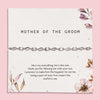
The Origins of Friendship Bracelets: A Timeless Tradition of Connection
Why do we buy friendship bracelets?
Friendship bracelets, those colourful symbols of connection, have a rich history that spans cultures and centuries. They are not just pieces of jewellery but meaningful tokens of affection, often given as friendship gifts to best friends or women who hold a special place in one's heart. Let's delve into the fascinating origins of these beloved accessories and explore their journey from ancient traditions to modern-day friendship tokens.
The Ancient Roots of Friendship Bracelets
The origins of friendship bracelets can be traced back to the indigenous cultures of Central and South America, particularly among the Native American tribes. These bracelets were traditionally handcrafted using techniques passed down through generations, symbolizing bonds of friendship and mutual respect. The intricate designs and vibrant colours were not only aesthetically pleasing but also carried specific meanings and stories.
The Hippy Movement
The popularity of friendship bracelets surged during the 1970s, thanks to the hippie movement. Embracing the ideals of peace, love, and unity, hippies adopted friendship bracelets as symbols of their commitment to these values. The bracelets became a fashionable way to express individuality and forge connections within the community.
Modern-Day Friendship Gifts
Today, friendship bracelets have evolved into a popular choice for meaningful friendship gifts. They are often given to commemorate special occasions like birthdays or as tokens of appreciation for best friends. The tradition of exchanging these bracelets has been embraced worldwide, transcending cultural boundaries and becoming a universal gesture of friendship.
The Digital Age and Friendship Bracelets
In the digital age, the sentiment behind friendship bracelets remains strong. Social media platforms have facilitated the sharing of bracelet-making tutorials and various sentimental gifts, allowing enthusiasts to connect. Additionally, the rise of e-commerce has made it easier to purchase and send these thoughtful gifts to friends across the globe, further cementing their status as cherished friendship gifts.
So, where do Friendship Bracelets come from?
From their ancient origins to their contemporary status as meaningful friendship gifts, friendship bracelets continue to symbolise the enduring bonds between friends. Whether handmade or purchased, these colourful tokens of affection remind us of the importance of connection and the joy that comes from sharing moments with those we care about. So, next time you consider a gift for your best friend or a loved one, remember the timeless tradition of the friendship bracelet—a simple yet profound way to celebrate the beauty of friendship.















































